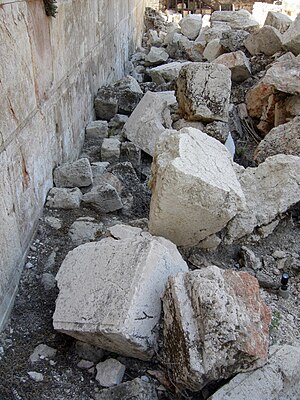Image: Model of the Temple in Jerusalem before its destruction by the Romans in 70 CE. (noamhen / Pixabay)
Beit HaMikdash means “the holy house,” and it refers exclusively to the Temple in Jerusalem. Bayit means house (beit is a grammatical construct that makes it into “house of.”) HaMikdash comes from the root kuf-dalet-shin, which denotes holiness. The specific term Beit HaMikdash appears in rabbinic literature but not in the Tanakh.
In Tanakh, the Jewish Bible, the Temple is usually referred to as HaBayit, the House. It is the dwelling place for God’s presence with Israel.
Some terms to know:
- Beit HaMikdash – The Temple in Jerusalem
- 1st Temple or Temple of Solomon – built by Solomon, destroyed by Babylonian armies in 586 BCE.
- 2nd Temple – rebuilt with permission of Cyrus of Persia in 538 BCE.
- Herod’s Temple – the 2nd Temple, expanded and elaborated by Herod the Great in 20 BCE.
- Churban – (khoor-BAHN) The destruction of the Temple.
- Holy of Holies – the centermost enclosure of the Temple where only the High Priest was permitted to go.
- Kotel, Western Wall – An area on the western side of the Temple Mount where Jews traditionally go to pray (since the Temple Mount is forbidden.) Sometimes it is referred to as the “Wailing Wall” but Jews do not use that name for it, because it was coined in derision of the Jews who wept for the lost Temple.
A timeline of the Temple and its site:
- 10th c. BCE – Built by King Solomon, heir of King David.
- 587 BCE – Destroyed by the Babylonians. (Tisha B’Av)
- 538 BCE – Rebuilding authorized by Cyrus the Great of Persia.
- 168 BCE – Seleucid King Antiochus IV Epiphanes orders sacrifices to Greek gods in the Temple, Maccabean Revolt erupts.
- 165 BCE – Rededication of the Temple (Chanukah)
- 20 BCE – Expansion and decoration of the Temple by King Herod
- 70 CE – The Temple is destroyed by Roman legionnaires. (Tisha B’Av)
- 361 CE – Roman Emperor Julian makes plans to rebuild the Temple
- 363 CE – Julian’s death and the Galilee earthquake of 363 put an end to rebuilding plans.
- 7th c. CE – Umayyad Caliph Abd al-Malik ibn Marwan ordered the construction of an Islamic shrine, the Dome of the Rock, on the Temple Mount, as well as the Al Aqsa Mosque.
- 1967 CE – Israeli troops capture the Old City in Jerusalem from Jordan during the Six Day War. This marks the first time since 70 CE that Jews have been free to visit the Western Wall at will. The Muslim Waqf retains administrative control of the Temple Mount itself.
Some Jews continue to pray daily for the Temple to be rebuilt on the same site in Jerusalem. Other Jews believe that the time of the Temple is past and they do not look to rebuild it.









